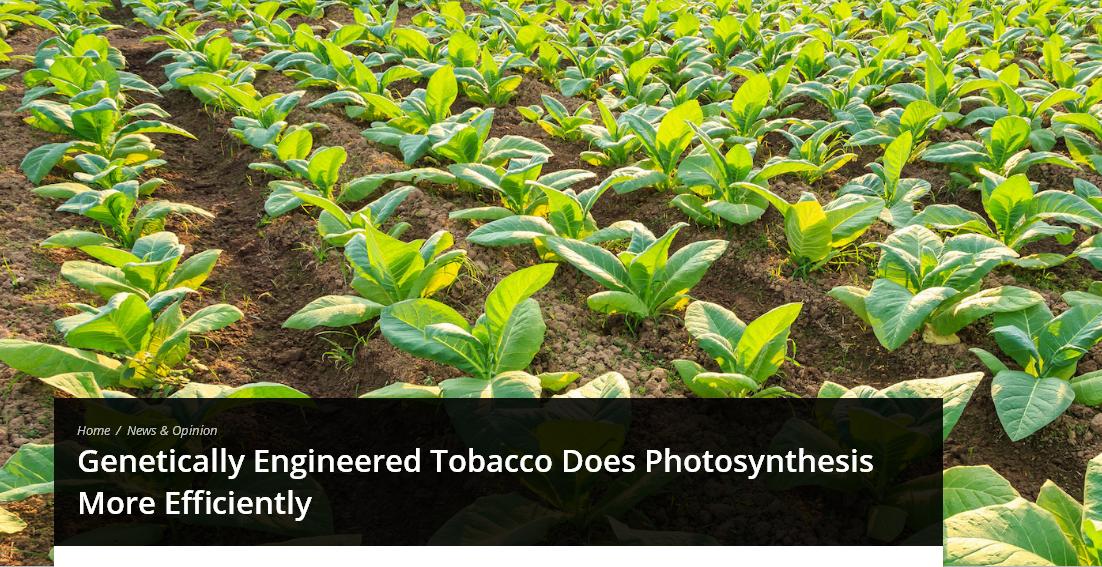博文
转基因烟草增收提高40%(附原文)
|||
转基因烟草增收提高40%(附原文)
诸平

据《科学家》(The Scientist)杂志2019年1月4日报道,美国科学家通过基因工程技术使烟草生物质增收提高40%,相关研究结果已经在4日的《科学》(Science)杂志网站发表——Paul F. South, Amanda P. Cavanagh, Helen W. Liu, Donald R. Ort. Synthetic glycolate metabolism pathways stimulate crop growth and productivity in the field. Science, 04 Jan 2019: Vol. 363, Issue 6422, eaat9077. DOI: 10.1126/science.aat9077.
Synthetic glycolate metabolism pathways stimulate crop growth.pdf
此项研究是美国农业部的研究人员与美国伊利诺伊大学香槟分校(University of Illinois at Urbana-Champaign)研究人员合作完成的。据研究者介绍,基因工程技术使烟草的光合作用更加有效,最终导致烟草生物质产量提升40%。当然,研究者希望将此项技术应用于更多农作物,如大豆、土豆等,更多信息请注意浏览原文或者相关报道。
The modification beefed up plant biomass by 40 percent in field tests.
Jan 4, 2019
CAROLYN WILKE
ABOVE: © ISTOCK.COM,
PHANUWATNANDEE
Ahack to the photosynthesis of tobacco increased its growth by 40 percent, researchers reported today in Science. The team now hopes to make similar changes to soybeans, potatoes, and other food crops.
The researchers from US Department of Agriculture and the University of Illinois at Urbana-Champaign introduced genetic constructs that tweaked a process called photorespiration in tobacco plants. Photorespiration occurs when an enzyme named Rubisco accidentally grabs an oxygen molecule instead of the carbon dioxide that plants need for growth. This snafu, which occurs roughly 20 percent of the time, results in a plant making a toxic chemical called glycolate.
To get rid of the glycolate, plants transform it into useful compounds through a series of chemical reactions that happen in multiple parts of the cell and reduce the photosynthetic efficiency by up to 50 percent. To recover efficiency, researchers gave their tobacco plants genetic instructions that keep the glycolate in one cellular compartment and transform it there.
The researchers tested how these genetically engineered tobacco plants fared under typical farming conditions in a field. The modified tobacco grew around 40 percent more biomass than unaltered plants.
The researchers hope that this tweak to photosynthesis can enhance plants used for food, too. They are currently testing whether these types of modifications help potatoes in greenhouse experiments, reports Science News. And the team plans on running similar experiments with rice, soybeans, and black-eyed peas.
MIT Technology Review notes that it could take decades to both prove that these genetic modifications produce more food and gain regulatory approval for the crops.
Structured Abstract
INTRODUCTION
Meeting food demands for the growing global human population requires improving crop productivity, and large gains are possible through enhancing photosynthetic efficiency. Photosynthesis requires the carboxylation of ribulose-1,5-bisphosphate (RuBP) by ribulose-1,5-bisphosphate carboxylase-oxygenase (RuBisCO), but photorespiration occurs in most plants such as soybean, rice, and wheat (known as C3 crops) when RuBisCO oxygenates RuBP instead, requiring costly processing of toxic byproducts such as glycolate. Photorespiration can reduce C3 crop photosynthetic efficiency by 20 to 50%. Although various strategies exist for lowering the costs of photorespiration, chamber- and greenhouse-grown plants with altered photorespiratory pathways within the chloroplast have shown promising results, including increased photosynthetic rates and plant size.
RATIONALE
To determine if alternative photorespiratory pathways could effectively improve C3 field crop productivity, we tested the performance of three alternative photorespiratory pathways in field-grown tobacco. One pathway used five genes from the Escherichia coli glycolate oxidation pathway; a second pathway used glycolate oxidase and malate synthase from plants and catalase from E. coli; and the third pathway used plant malate synthase and a green algal glycolate dehydrogenase. All enzymes in the alternative pathway designs were directed to the chloroplast. RNA interference (RNAi) was also used to down-regulate a native chloroplast glycolate transporter in the photorespiratory pathway, thereby limiting metabolite flux through the native pathway. The three pathways were introduced with and without the transporter RNAi construct into tobacco, which is an ideal model field crop because it is easily transformed, has a short life cycle, produces large quantities of seed, and develops a robust canopy similar to that of other field crops.
RESULTS
Using a synthetic biology approach to vary promoter gene combinations, we generated a total of 17 construct designs of the three pathways with and without the transporter RNAi construct. Initial screens for photoprotection by alternative pathway function under high–photorespiratory stress conditions identified three to five independent transformants of each design for further analysis. Gene and protein expression analyses confirmed expression of the introduced genes and suppression of the native transporter in RNAi plants. In greenhouse screens, pathway 1 increased biomass by nearly 13%. Pathway 2 showed no benefit compared to wild type. Introduction of pathway 3 increased biomass by 18% without RNAi and 24% with RNAi, which were consistent with changes in photorespiratory metabolism and higher photosynthetic rates. Ultimately, field testing across two different growing seasons showed >25% increase in biomass of pathway 3 plants compared to wild type, and with RNAi productivity increased by >40%. In addition, this pathway increased the light-use efficiency of photosynthesis by 17% in the field.
CONCLUSION
Engineering more efficient photorespiratory pathways into tobacco while inhibiting the native pathway markedly increased both photosynthetic efficiency and vegetative biomass. We are optimistic that similar gains may be achieved and translated into increased yield in C3 grain crops because photorespiration is common to all C3 plants and higher photosynthetic rates under elevated CO2, which suppresses photorespiration and increases harvestable yield in C3 crops.
Alternative photorespiratory pathways in tobacco.
Three alternative pathways [1 (red), 2 (dark blue), and 3(light blue)] introduced into tobacco chloroplasts for more efficient recycling of glycolate. RNAi suppresses the native glycolate/glycerate transporter PLGG1 to prevent glycolate from leaving the chloroplast and entering the native pathway (gray).
https://blog.sciencenet.cn/blog-212210-1155503.html
上一篇:蒲公英化学成分
下一篇:全国空气质量杨凌最差,宝鸡次之
